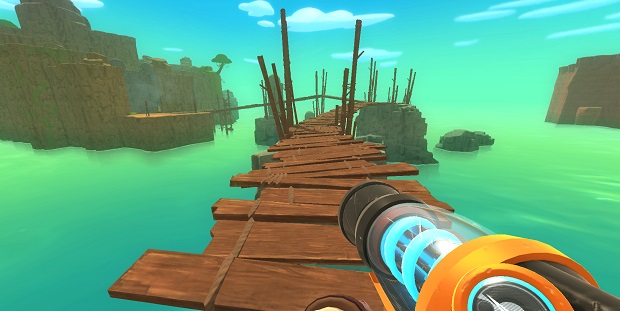Poop And Profit: Slime Rancher's Fantastic Farming
Fecal Farming Simulator
Slime Rancher [official site] is the cutest game about selling shit ever made. Admittedly it's probably the only game about selling shit ever made, but I don't know for certain and googling "Shitselling games" tends to bring up commercial flops like Bulletstorm rather than games that literally involve the flogging of faecal matter.
If you've seen anything of Monomi Park's debut, which slithered onto Early Access a couple of weeks back leaving a silvery trail in its wake, then its love for excrement may come as a surprise. Aesthetically Slime Rancher is a thundering wave of colour, like a circus struck by a tsunami, and the eponymous slimes are so clearly designed to be childfriendly that it's surprising to discover they have any orifices at all.
But as the title suggests, Slime Rancher is about working with animals and the land, and anyone who has been within several hundred yards of a farm will know that dung is absolutely fundamental to its function. Slime Rancher follows this proud if somewhat pungent tradition, although its own version of muckspreading is a little bit different.
Here's how it works. Slime Rancher takes place on a planet at the far rim of the galaxy, where the wildlife consists entirely of gelatinous globs and also chickens for some reason. You start the game inside the ranch itself, the area of which is divided into square plots of land where you can build corrals to keep slimes, vegetation plots to grow crops, chicken coops to keep hens and roosters, and a host of other important agricultural structures.
At this stage of development, the goal of the game is simply to make money, which you do by sucking up slimes in your "Vacpac" gun, depositing them in the corral, and feeding them. Once fed, slimes do a "plort", a sparkling bumnugget that can be sucked up and exchanged at the "plort market” for cash. The notion of crapping gems might seem like a nice visual euphemism, until you consider how astonishingly uncomfortable it must be. Perhaps that's why all the world's superrich tend to be so belligerent and illtempered.
So proceeds a fairly simple game about building and exploring, made interesting by those exuberant and brilliantly personable slimes. Different slimes have different needs, and egest plorts of different value. The starting "pink" slimes, for example, will eat absolutely anything and exist in abundance throughout the game's world, but will only nab you a handful of coins per plort. Rock slimes, by comparison, only eat carrots and can damage you as they roll around the world, but have plorts that are roughly three times more valuable than that of pink slimes.
My initial strategy, if you can call what ultimately proved a cavalcade of foolishness such a thing, was to build a basic corral, cram it full of pink slimes, and scoop the stinky pink cream off the top in between searching for more lucrative specimens. But slimes don't just sit around in their corral, they leap around and clamber on top of one another, and grow increasingly agitated the longer they go unfed.
On top of that, being the disgusting goobased lifeforms they are, slimes will eat the plorts of other slimes, which transforms them into a bloated crossbreed that does multiple plorts, but eats more food, is harder to contain, and is at risk of turning into something even worse.
Having left the ranch in search of new slimes to wrangle, I returned in the evening to total mayhem. The pink slimes were everywhere. They'd run amok in my carrot patch and had eaten that day's crop, meaning I had nothing to feed my rock slimes with. Worse, a few pink slimes had got into the corral reserved for my lovely feline "Tabby" slimes. Both species had clearly had a merry old time munching on each other's plorts, because the tabby corral was filled with fat, pink, catfaced mongrels. It was a disaster.
In the end, I did the only thing any selfrespecting Slime Rancher would do, and fired any slime coloured pink into the sea. If you think me heartless, know that the game's default method of dealing with unwanted slimes is to put them in an incinerator.
After what I began referring to as the Magenta Massacre, I restarted my ranch and focused purely on collecting the rarer slimes. You can barely go outside the ranch's bounds without stepping in a pink plort anyway, so there's little point wrangling them in the first place.
Although the game has only just landed on Early Access, the behaviour of the various slimes already impresses. If you build a chicken coop next to a Tabby slime corral, for example, the Tabby slimes will bunch up on one side, leering at the hens with hungry eyes. Later on you must deal with slimes with far more dramatic behaviours, such as "Boom" slimes that bounce madly around their corral from the force of their own concussions, and Honey Slimes with plorts so delicious that other slimes will be drawn to them from right across the ranch.
To keep up with your slimes' increasing demands, corrals can be expanded in various ways, like building higher forcefields to prevent escapes, or adding an automated "plort collector", which is vitally important for ranching the more dangerous slimes without being pummelled and burned. As you become more proficient, play evolves from you zooming around doing everything yourself, like a parent rearing dozens of diarrhoeastricken toddlers, to relying on more automated processes that allow you venture from the ranch for longer periods of time.
In terms of its interface, Slime Rancher is light and breezy. You glide around the map like a professional iceskater, and few jobs on the ranch take longer than a minute. Aside from a couple of tasks such as construction, most actions are completed using the vacpac, whether it's sucking up slimes from the wild, pulling fruit off trees or carrots from the ground, feeding chickens to your tabby slimes and watching with something between mirth and horror as a sickeningly cute catface opens like a beartrap and devours the poor bird in a single bite.
The tone of the game is absolutely spot on. Even the grimmest of ranch jobs is offset with its daftly comic theme, be it through a sound effect or the slimes' naturally squidgy physics. The mechanics lend themselves to humour equally well. Several times I've accidentally fired plorts into a corral rather than food, resulting in a mass mutation of my slimes as they greedily chowed down.
Unfortunately, while the slimes of Slime Rancher are excellent fun to play with, the world itself is not. I expected a typical sandbox affair where you begin close to the centre of the map and can strike out in any direction, but instead the landscape consists of rather crude environmental corridors that funnel you in very specific ways. There are several boarded off areas that are obviously still work-in-progress, and will hopefully provide a touch more freedom.
Even so, I'm not convinced by Slime Rancher's spiderweblike approach to environment design. It necessitates a lot of backtracking through the exact same area, killing any desire to explore faster than a summer storm. The developers have attempted to mitigate this through sparsely placed teleporting platforms, but these don't make the game any better suited to its linear level structure.
In addition, as I already mentioned, currently there isn't much of a goal apart from accruing money. The only underlying system that directs your play is the plort market, as it fluctuates depending on what you sell. Hawking large amounts of one particular plort causes the overall price to drop, thus encouraging you to seek out other slimes.
Slime Ranchers is also an incredibly easy game, which in a way is a relief given I've been playing it alongside XCOM 2: Enemy Unleashed. Yet while Slime Rancher will keep you bustling in a pleasant haze for a good few hours, at this stage it does eventually run out of steam.
Nevertheless, I adore the concept. There isn't anything else quite like Slime Rancher around. You can glimpse a little Pokémon here, a bit of Dungeon Keeper there, but the way it blends all those elements together is genuinely unique. And there's masses of potential in using the slime AI to create emergent puzzles, especially if Monomi Park can create modes of interaction between them that don't involve coprophagia.
Slime Rancher is available, in Early Access, now.






















